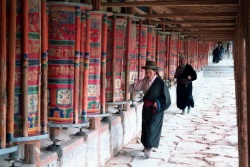Prayer Wheels
Prayer Wheels are another typical Tibetan Phenomena. They are usually crammed with mantras, and similar to prayer flags,it is taught that the Power of the mantras will spread when the Wheel is turned. The more mantras, the better. Prayer wheels come in many variations; from handheld, like the one on the left, to huge ones that require serious muscle Power to set in motion. They can be moved by hands, water or wind- even your hard disk can function as a prayer Wheel.
They are also called Mani-wheels, as the wheels usually contain the Mantra OM MANI PADME HUM. Tibetan prayer wheels (called Mani wheels by the Tibetans) are devices for spreading spiritual Blessings and well being. Rolls of thin paper, imprinted with many, many copies of the Mantra (prayer) Om Mani Padme Hum, printed in an ancient Indian script or in Tibetan script, are wound around an axle in a protective container, and spun around and around. Typically, larger decorative versions of the syllables of the Mantra are also carved on the outside cover of the Wheel.
Tibetan Buddhists believe that saying this Mantra, out loud or silently to oneself, invokes the powerful benevolent attention and Blessings of Chenrezig, the embodiment of Compassion.
Viewing a written copy of the Mantra is said to have the same effect -- and the Mantra is carved into stones left in piles near paths where travelers will see them. Spinning the written Form of the Mantra around in a Mani Wheel is also supposed to have the same effect; the more copies of the Mantra, the more the benefit.
Traditionally wheels were not used at all in Tibet except for spiritual purposes -- carts and similar wheeled devices were known from other cultures, but their use was intentionally avoided. The earliest known mention of prayer wheels is in an account written by a Chinese pilgrim, in 400 AD, while traveling through the area now known as Ladakh. The idea is said to have originated as a play on the phrase "turn the Wheel of the Dharma," a classical metaphor for Buddha's teaching activity.
Mani wheels are found all over Tibet and in areas influenced by Tibetan culture. There are many types of Mani wheels, but small hand-held wheels, like the one shown here, are the most common by far. Tibetan people carry them around for hours, and even on long pilgrimages, spinning them any time they have a hand free.
Larger wheels, which may be several yards (meters) high and one or two yards (meters) in diameter, can contain myriad copies of the Mantra, and may also contain sacred texts, up to hundreds of volumes.
They can be found mounted in rows next to pathways, to be spun by people entering a shrine, or along the route which people use as they walk slowly around and around a sacred site -- a Form of spiritual practice called circumambulation.
Wheels are also placed where they can be spun by wind or by flowing water. Smaller mounted wheels can be spun by the heat rising from a flame or by steam from a stove, or placed on a tabletop to be spun by hand.
Tibetan Buddhist Mani wheels are always spun clockwise, as viewed from above, for any or all of several reasons: It rotates the syllables of the Mantra so that they would pass a viewer in the order that they would be read, it follows the direction of the sun, and it matches the clockwise circumambulation of stupas. Practitioners of Bon, the pre Buddhist spiritual tradition of Tibet, spin their prayer wheels counter-clockwise, the same direction they use in circumambulation.
Much of Tibetan culture has now had to take Refuge outside its homeland. In Tibet under Chinese rule, mechanical wheels are everywhere, on trucks and busses and cars and tanks, but spiritual training and practice, and even learning the Tibetan Language, are severely restricted.
With the introduction of Tibetan Buddhism into the West, new types of Mani wheels have come into being. His Holiness the Dalai Lama has said that having the Mantra on your computer works the same as a traditional prayer Wheel. Since a computer's hard disk spins hundreds of thousands of times per hour, and can contain many copies of the Mantra, anyone who wants to can turn their computer into a prayer Wheel. The animated image here on the right is another Form of digital prayer Wheel.
People who feel more strongly connected to prayers other than the Om Mani Padme Hum Mantra of Chenrezig can create prayer wheels, of either the mechanical or the electronic type, with the prayers that mean the most to them -- and people who feel a connection to the modern ecumenical or "Great Awakening" movements can include prayers from many traditions, written in any number of languages.
